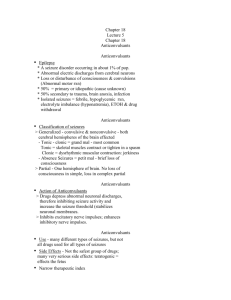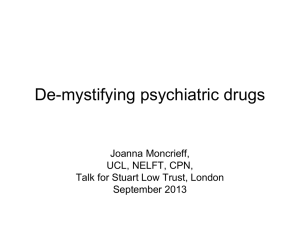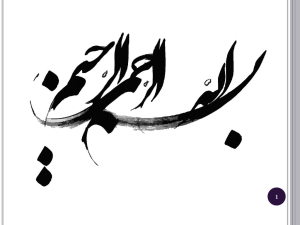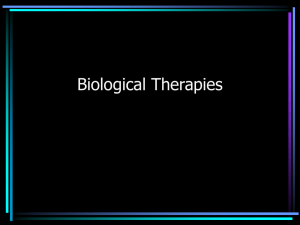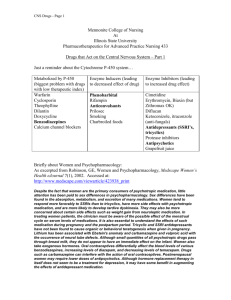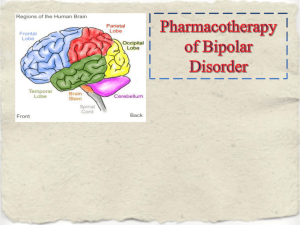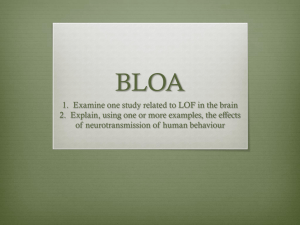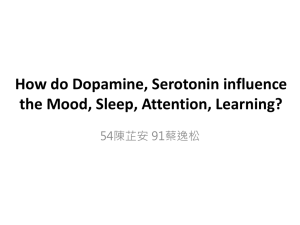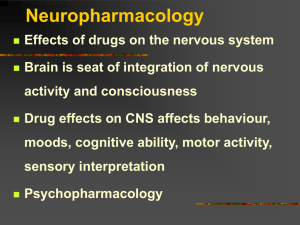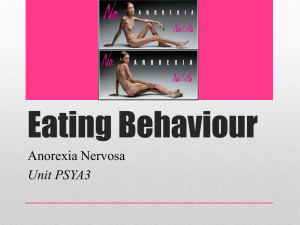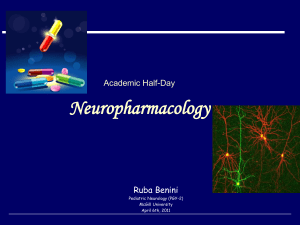Use - Harper College
advertisement
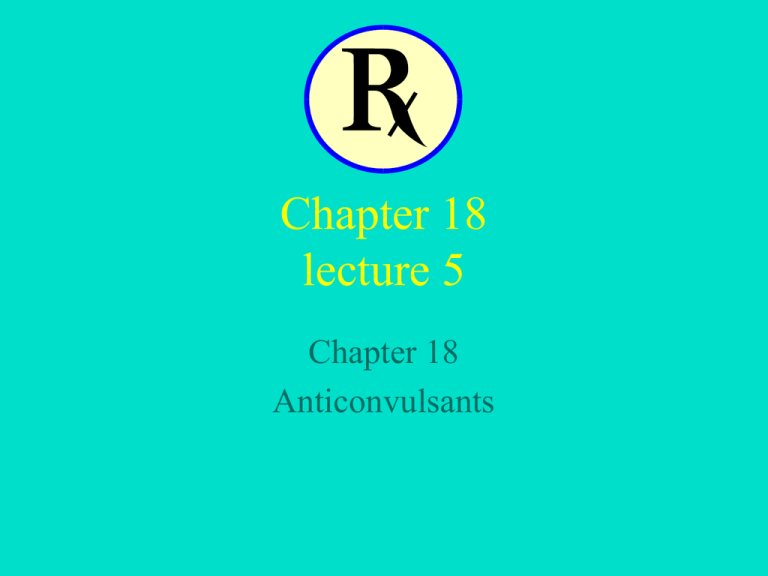
Chapter 18 lecture 5 Chapter 18 Anticonvulsants Anticonvulsants • Epilepsy * A seizure disorder occurring in about 1% of pop. * Abnormal electric discharges from cerebral neurons * Loss or disturbance of consciousness & convulsions (Abnormal motor rxn) * 50% = primary or idiopathic (cause unknown) * 50% secondary to trauma, brain anoxia, infection * Isolated seizures = febrile, hypoglycemic rxn, electrolyte imbalance (hyponatremia), ETOH & drug withdrawal Anticonvulsants • Classification of seizures > Generalized - convulsive & nonconvulsive - both cerebral hemispheres of the brain effected - Tonic - clonic = grand mal - most common Tonic = skeletal muscles contract or tighten in a spasm Clonic = dysrhythmic muscular contraction: jerkiness - Absence Seizures = petit mal - brief loss of consciousness > Partial - One hemisphere of brain. No loss of consciousness in simple, loss in complex partial Anticonvulsants • Action of Anticonvulsants > Drugs depress abnormal neuronal discharges, therefore inhibiting seizure activity and increase the seizure threshold (stabilizes neuronal membranes. > Inhibits excitatory nerve impulses; enhances inhibitory nerve impulses. Anticonvulsants • Use - many different types of seizures, but not all drugs used for all types of seizures • Side Effects - Not the safest group of drugs; many very serious side effects: teratogenic = effects the fetus • Narrow therapeutic index • Usually taken throughout a persons lifetime compliance issues Anticonvulsants Hydantoins • Phenytoin (Dilantin) - since 1938 * Least toxic, nonaddicting, sm. sedating effect * Dosage varies according to age * Narrow therapeutic index = monitoring serum drug levels a must * Highly protein bound Drug-drug interactions * Action - Reduces motor cortex activity by altering transport of ions inhibits spread of seizure activity * Uses - Grand mal & complex partial seizures Anticonvulsants Phenytoin (Dilantin) • Side effects - Gingival Hyperplasia = overgrowth of the gums - good oral hygiene a must! * Long term use may elevate blood sugars • Drug Interactions - Lots!! Anticonvulsants Barbiturates • Phenobarbital - long acting * Use - grand mal seizures & acute episode of of status epilepticus (rapid succession of seizures) * Action - Increases seizure threshold in motor cortex * SE - General sedation & client tolerance Anticonvulsants Miscellaneous Agents • Carbamazepine (Tegretol) * Use - Grand mal, psychomotor, mixed seizures, & when other anticonvulsants do not work * Action - Unknown - Thought to work in Na ions during generation of nerve impulses * SE - Aplastic anemia (abnormal regeneration of RBC’s), agranulocytosis (great in leukocytes an increase risk of infection Anticonvulsants Miscellaneous Agents • Valproic Acid (Depakote) * Use - Petit mal, grand mal, & mixed type of seizures * Action - Unclear - Probably increases brain levels of GABA which transmits inhibitory nerve impulses in the CNS * SE - Hepatotoxicity, esp. in young children * DI - Lots !! Chapter 19 Antipsychotics, Anxiolytics, and Antidepressants Antipsychotics • Used to treat symptoms of mental disorders • Also known as neuroleptics & psychotropics • Neuroleptic = any drug that modifies plychotic behavior, thus exerting antipsychotic effect • Psychosis = symptomatic in a variety of mental or psychiatric disorders - Characterized by more than one symptom - diff. in processing info., delusions, hallucinations, incoherence, catatonia, aggressive or violent behavior Antipsychotics • Schizophrenia - Chronic, major category of psychosis - Usually occurs in adolescence or early adulhood - Positive Symptoms = agitation, incoherent speech, hallucination, delusion, & paranoia - Negative Symptoms = or loss in function & motivation, poverty of speech content, poor self-care, social withdrawl - more chronic & persistent * Traditional (typical) antipsychotics more helpful for managing poss. symptoms than neg. * A new group (atypical) more useful in treating both pos. & neg. symptoms of schizophrenia Antipsychotics • • • • Comprise the largest group of drugs to treat mental illness improve the thought processes & behavior Not used for treating anxiety & depression Theory - psychotic symptoms result from an imbalance of the neruotransmitter dopamine in the brain (these drugs sometimes called dopamine agonists) • Antipsychotics block D2 dopamine receptors in the brain = a dec. in psychotic symptoms. • Many block the chemoreceptor trigger zone in the brain = antiemetic effect Antipsychotics • Side Effects - Pseudoparkinsonism = a major side effect of typical antipsychotic drugs - Extrapyramidal symptoms (EPS) - mask-like faces, rigidity, tremors, pill-rolling * With high doses of drugs symptoms are more pronounced - Acute dystonia - muscle spasms of face, tongue, neck & back - treat with anticholinergics (Cogentin) - akathisia - trouble standing still, pacing, constant motion treat with benzodiazepines or beta blockers - Tardive dyskinesia - serious with long term use of drug protrusion/rolling of tongue, sucking/smacking of lips, chewing motion - best to D/C the drug Antipsychotics Phenothiazines • Three groups: Aliphatic, Piperazine, & Piperidine - differ mostly in their side effects • Most of the antipsychotics can be given orally, IM, or IV • Chlorpromazine (Thorazine) - First drug - aliphatic - Action - alt. in DA effect on CNS - Use - psychosis, Hiccups, - SE - sedation, EPS, - Adverse rxns - Hypotension, tachycardia ( pulse rate), tardive dyskinesia, seizures Antipaychotics Phenothiazines • Prochlorperazine (Compazine) - piperazine - low sedative - Use - antiemetic - Action - Acts on chemoreceptor trigger zone to inhibit N&V - SE - EPS symptoms, orthostatic hypotension • Thioridazine (Mellaril) - piperidine - strong sedative - Use - Psychosis - Action - Unknown - probably blocks postsynaptic DA receptors in the brain - SE - Low incidence of EPS Antipsychotics Nonphenothiazines • Haloperidol (Haldol) - a potent antipsychotic drug whose dose is smaller than less potent drugs - Similar to phenothiazines in pharmacologic action - Action - Alters the effects of dopamine by blocking dopamine receptors - Use - Psychoses, Tourette’s syndrome - SE - EPS symptoms, photosensitivity, hypotension - CI - Glaucoma, severe hepatic, renal & CV disease Antipsychotics Atypical • • • • New category since early 1900’s Treats pos & neg symptoms of schizophrenia Not likely to cause EPS or tardive dyskinesia clozapine (Clozaril), risperidone (Risperdal), olanzapine (Zyprexa) & quetiapine (Seroquel) • Clozapine - can cause aggranulocytosis dec. in body’s defense mechanism & seizures - used for severely ill only • Risperdal, Zyprexa & Seroquel - Do not cause aggranulocytosis, similar action to Clozaril Anxiolytics or Antianxiety Drugs • Primarily used for treating anxiety and insomnia • Major group = benzodiazepines - a minor tranquilizer group • More effective than barbiturates - enhance action of GABA within the CNS, have fewer side effects, less dangerous in overdosing - Wide therapeutic index • Used when anxiety is excessive & could be disabling • These agents treat the symptoms - not the cause • Long term use discouraged - tolerance can occur • Nonpharmacologic measures should be tried first, before giving anxiolytics Anxiolytics Benzodiazepines • Multiple uses: anticonvulsants, antihypertensives, sedative-hypnotics, pre -op drugs & anxiolytics • Used mainly for severe or prolonged anxiety, panic attacks, phobias, compulsions ( not day to day stress) • 3 frequently used = diazepam (Valium), alprazolam (Xanax), & lorazepam (Ativan) • Highly protein bound & could displace other highly protein bound drugs • Controlled substances - class IV • Avoid ETOH an in CNS depression Anxiolytics Benzodiazepines • Diazepam (Valium) - Action - acts on limbic & subcortical levels of CNS - Use - control anxiety, pre-op, muscle relaxant, ETOH withdrawl, anticonvulsant - SE - Drowsiness, orthostatic hypotension, confusion - CI - Pregnancy - Potential to cause fetal birth defects - Alert - Do not D/C abruptly = withdrawl symptoms • Buspirone hydrochloride (BuSpar) - newest anxiolytic - Action - ?? - may inhibit neuronal firing, serotonin - Use - short-term relief of anxiety. 1-2 weeks for relief - SE - < benzodiazepines, but still monitor CNS Antidepressants • Depression is the most common psychiatric problem, about 10 - 20% of pop. affected • Def. - mood changes & loss of interest in normal activities, occurs every day for at least 2 weeks, interferes with daily functioning. Symptoms: loss if interest in most activities, weight loss or gain, insomnia or hypersomnia, loss of energy, fatigue, feelings of dispair, suicidal thoughts. • Cause - Genetic, social & environmental factors, change in neurotransmitter (NT) levels - norep. and/or serotonin in the brain Antidepressants • Action - Antidepressants work to normalize NT balance • Classes of drugs include: - Tricyclic antidepressants (TCAs) or tricyclics - Selective serotonin reuptake inhibitors (SSRIs) & atypical antidepressants - Monoamine oxidase (MAO) • Most drugs need to be taken for 2-4 weeks for full effect • Treatment should continue for 9 months after remission of 1st episode; 5 yrs after 2nd; indefinitely after 3rd Antidepressant Agents Tricyclic Antidepressants • Amitriptyline (Elavil) *Action - Serotonin & Norep. increased in nerve cells *Use - Depression & anxiety * SE - Sedation, drowsiness, anticholinergic effects (dry mouth, urinary retention, constipation), EPS, orthostatic hypotension Antidepressant Agents Selective serotonin Reuptake inhibitors (SSRI) • Action - not well defined - blocks reuptake of serotonin into the nerve terminal of the CNS • Do not block uptake of dopamine or norep. • Do not block cholinergic receptors • More commonly used to treat depression D/T fewer side effects - but more costly • Use - major depressive disorders, anxiety disorders, panic attacks, phobias, • 4 SSRI’s since 1988: fluoxetine (Prozac), fluvoxamine (Luvox), sertraline (Zoloft), paroxetine (Paxil) Antidepressants SSRI’s • Fluoxetine (Prozac) - most commonly prescribed *Action - ?? - Thought to inhibit reuptake of seretonin * Use - Depression, obsessive-compulsive disorders, bulimia * SE - agitation, nervousness, insomnia, wt. loss * DI - Lots!!1 * Onset of effect between 1 and 4 weeks * Some clients experience sexual dysfuction Antidepressants Monoamine Oxidase Inhibitors • Monoamine oxidase (MAO) - an enzyme normally inactivates norep., dopamine, epi. & serotonin. By inhibiting = rise in these NT’s • 2 forms of MAO - A & B - MAO -A inactivates DA in the brain - MAO -B inactivates norep. & serotonit • MAOI’s are nonselective = inhibits both A & B • Inhibition is thought to relieve symptoms of depression Antidepressants MAOI’s • 3 MAOI’s currently prescribed: tranylcypromine sulfate (Parnate), phenelzine sulfate (Nardil), isocarboxazid (Marplan) • As effective as TCA’s for treating depression, but D/T side effect of hypertensive crisis resulting from food & drug interactions, only 1% of clients use - tyramine rich foods & CNS stimulants can cause the crisis Bipolar disorder Lithium • Used mostly for the manic phase of manic-depressive illness - has a calming effect without impairing intellectual activity • Increases receptor sensitivity to serotonin • Has a narrow therapeutic index - monitor biweekly until theraputic level reached then monitor monthly - monitor sodium levels since lithium tends to dec. Na • SE - dry mouth, thirst, increase urination, weight gain • May have teratogenic effects on fetus • Depakote is now being used to treat bipolar disorder
